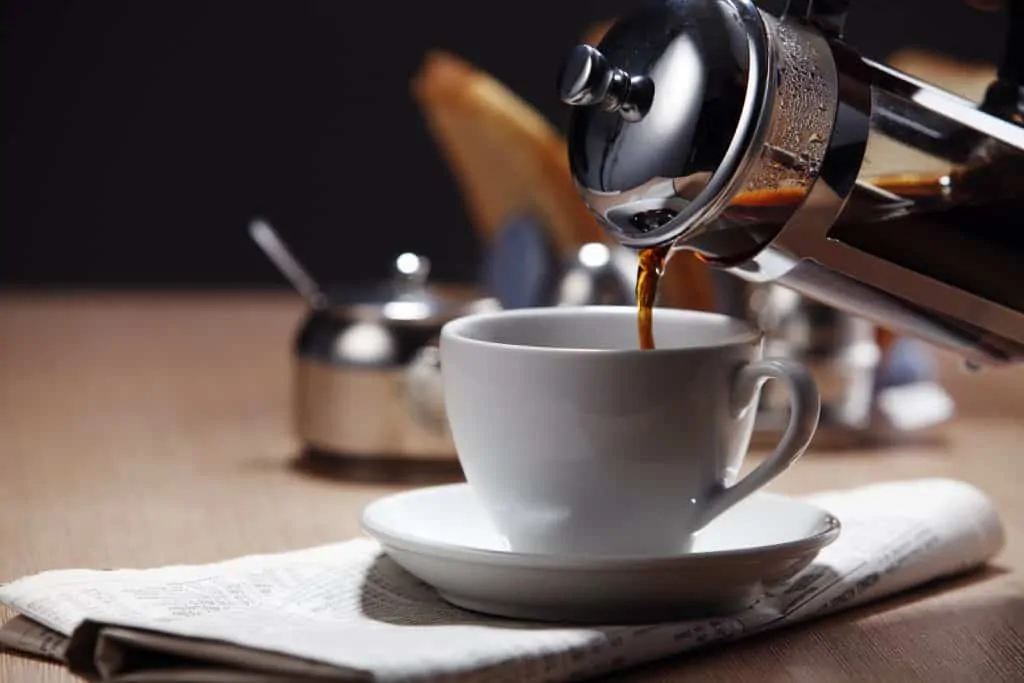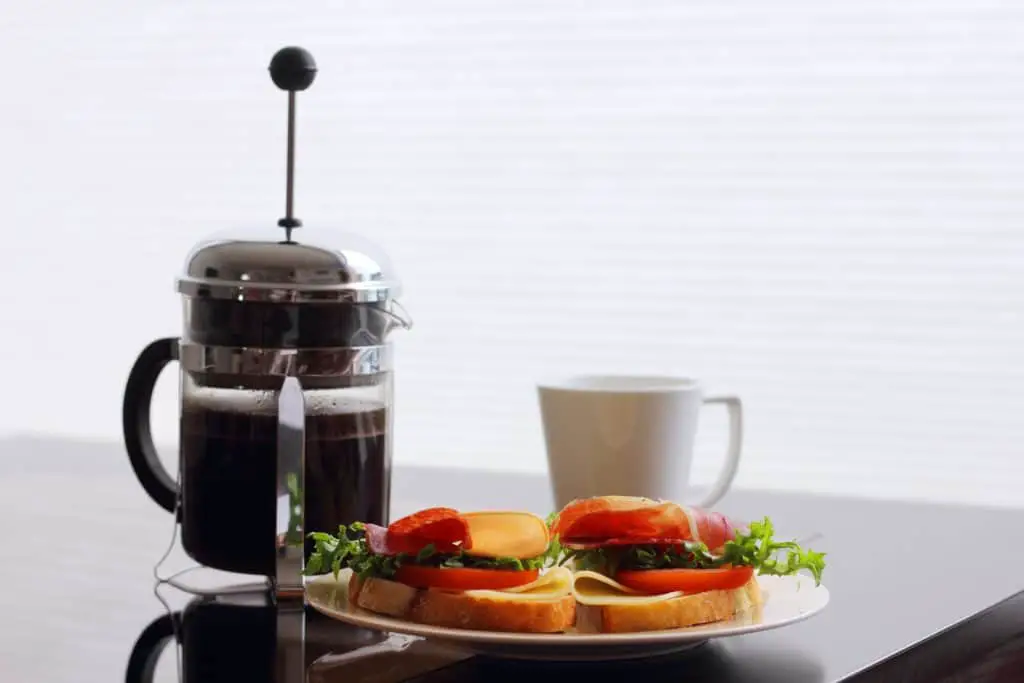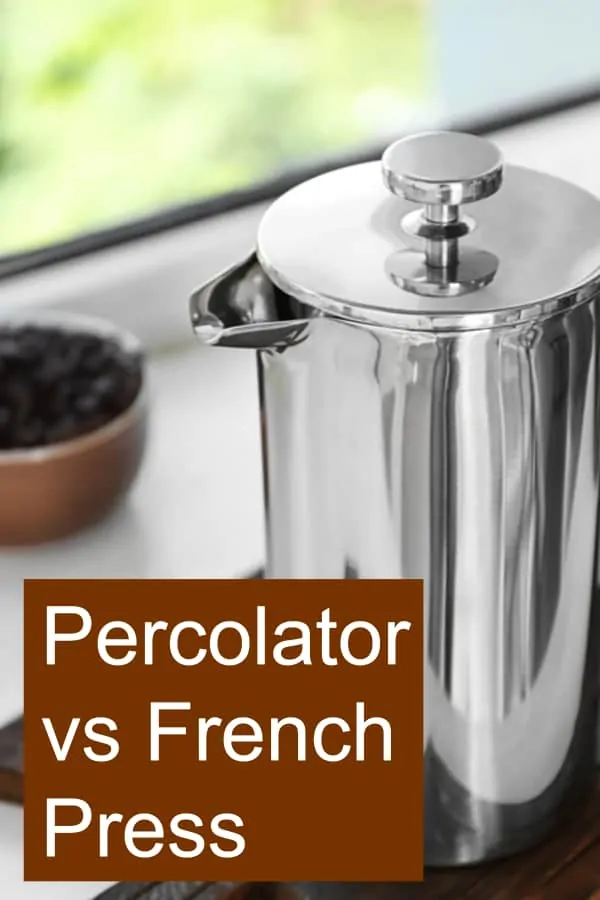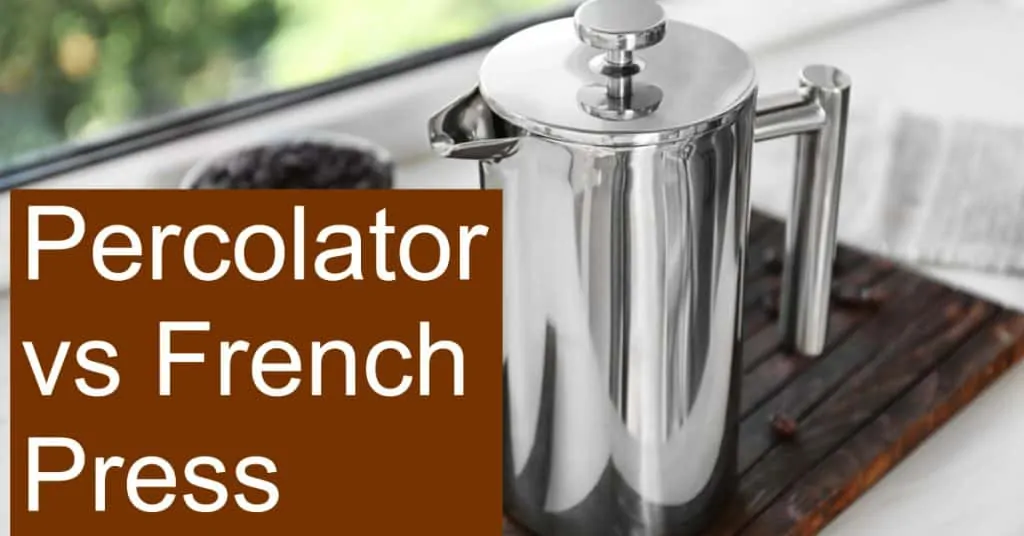Percolators and French Presses are some of the most commonly seen coffee brewers. But, would you know which one you should choose? Which is easier to use and is cheaper? Let’s have a French Press vs Percolator comparison and come up with all the essential answers to your questions!
What Is a Percolator? How Does it Work?
Percolators are some of the oldest coffee makers on the planet, and they started out as stovetop coffee pots. While many percolators still operate this way, some companies are now making percolators that plug in and work a little faster. Nevertheless, percolators all work the same way, and it starts with boiling water and that water being pushed up toward the top of the coffee pot to brew the coffee grounds. With a percolator, there is a tube running through the middle of the pot, and once you put water in the bottom of the pot, it is pushed through that tube once it starts boiling and pours itself onto the coffee grounds, which are located somewhere near the top of the machine.

What is pourover Coffee? What is the perfect pour-over technique?
The spreader cover is the component that holds the coffee grounds (How many times can coffee grounds be used?), and it contains holes at the bottom so that the boiled water is dispersed evenly, which results in a better cup of coffee. This cover is usually fairly tall as well, which prevents coffee grounds from being spilled over into the brewed coffee – a very important task indeed. As the coffee is brewing, the water continuously splashes up through the tube and down over the spreader cover, and it keeps doing this over and over again until the coffee is finished brewing.
Another aspect of a percolator that is interesting is that there is often a clear lever on the top of the lid that allows you to view the coffee going up and down as it’s being percolated and brewed. Percolating coffee machines can also be a little loud, but this means you’ll know immediately once the coffee is brewed because you won’t see the coffee going up and down in the lid and you won’t hear it brewing the coffee inside of the pot – Check out our coffee percolator vs drip comparison.
What Is a French Press? How Does it Work?
A French press coffee maker is manual just like most percolators are, and it is round and cylindrical in shape and comes with a handle. With this type of coffee pot, you will place coffee grounds inside of the pot then place warm water – not boiling water – over the grounds. In the meantime, you’ll use a plunging device that will separate the grounds from the coffee so that you get a rich flavor without tasting any leftover coffee grounds. You simply boil the water and then wait roughly 30 seconds because the water needs to get down to 200 degrees Fahrenheit (water boils at 212 degrees Fahrenheit). Then, you pour the water into the unit and use the plunger to make sure the coffee is brewed correctly.
A French press coffee maker is also a versatile type of coffee maker because you can use it to brew loose-leaf tea and even make cold coffee. Most of them are very inexpensive and extremely easy to use and clean. In addition, because they are used without any electricity or other power sources, they have a small carbon footprint and can be considered eco-friendly. On the other hand, they tend to be a little high-maintenance because you’ll need other things to operate them, including a thermometer, scale, coffee grinder, and a kettle or something else to boil the water.
Nevertheless, French press coffee pots are the preferred way to make coffee for millions of people all over the world, so this method of making coffee is not likely to disappear anytime soon.

Which Is Easier to Brew?
By most accounts, both percolators and French press coffee pots are easy to use because all you do is place water and coffee grounds in them and wait until the brewing process is complete. Most coffee aficionados agree that the French press coffee pot is a little easier to use because you can see what is going on inside of the pot and all you have to do is use the plunger to separate the grounds from the coffee and to keep everything moving along as it should be. You don’t even have to do this with a percolator, but it’s possible for you to feel a little less control over the brewing process with a percolator, as opposed to a French press coffee pot where you are actually doing something to control how well the coffee is being brewed.
This being said, both of these coffee pots are very simple to use and take no actual training. Just a few simple techniques to learn and you’re on your way to making a great pot of coffee without the need for a power source such as electricity. Best of all, not only are these two methods simple, but you can also make more than one cup of coffee at a time if you like. The French press coffee pots, for example, usually accommodate two to four cups of coffee at a time, which is good if more than one person will be joining you after the coffee is brewed.

Stovetop Percolator vs Moka Pot Coffee – What are the Differences?
What Kind of Grind Do You Need? Fine? Coarse?
With most coffee pots or coffee machines, you can use coffee grounds of any size you like, so whether you prefer coarse grounds, very fine grounds, or something in between the two, the choice is up to you. Nevertheless, this isn’t entirely true for a French press coffee pot. Why? Because French press coffee pots have a filter, but the filter (Cone vs Basket Filter – Does Shape Impact Coffee Flavor?) only traps medium-sized grinds. This means that only larger grounds, that is, coarser grounds, should be used in a French press coffee pot. With this type of coffee pot, there will always be some grit in the taste of the coffee, and the coffee will always be thicker than with other coffee makers.
French press coffee pots also allow for more flavor, however, in part because more essential oils are left over once the brewing process is complete. Those oils give coffee more flavor, but if you don’t want to experience any type of grit in your coffee, you might be better off using a percolator instead of a French press coffee pot. With the exception of very fine grounds, which tend to make the coffee a little sludgy, you can use any type of grounds you want in a percolator. In this respect, percolators are a bit more flexible and versatile than French press coffee pots, where only the larger grounds should be used.

What Type of Roast Produces Better Coffee? Dark? Light?
The dark roast versus light roast argument has been around for a while and isn’t likely to get settled anytime soon. A lot of this decision will depend on your personal preferences and tastes, but there are a few “facts” you should be aware of before you decide which type of coffee is best for you. First of all, the terms “light” and “dark” refer to how long the coffee beans are roasted, with the former being kept in the roaster for a much shorter period of time. The shorter the roasting time, the more caffeine is left in the beans and the denser the taste is. Shorter roasting times also allow for a more fruity and floral-like taste than the dark roast beans that roast much longer, which provide a nuttier and almost sweeter taste.
When it comes to the percolator and French press coffee pots, it is usually not recommended that you use a light roast with a percolator as a general rule. A percolator uses very hot water, which doesn’t always enhance the taste of light-roasted coffee beans as much as it does dark-roasted ones. Percolators should always be used with medium- or dark-roast coffees. A French press coffee pot can accommodate a light roast, because the water is not as warm and therefore enhances the true flavor of light-roast beans. When it comes to light-, medium-, and dark-roasted coffee, therefore, you can think of a French press coffee pot as being able to accommodate all of them, whereas a percolator should only be used for medium- to dark-roasted coffee.
Is a Percolator Less Expensive Than a French Press?
Overall, French press coffee pots tend to be a little more expensive than percolators, although prices of the two can vary quite a bit depending on the size, the brand name, and the extra features that come with the coffee maker. Typically a percolator and French Press will roughly come in at a similar price point.
When shopping for these types of coffee pots, you need to take a close look at what you’re getting in return. Many French press coffee pots come with everything you need to make a great cup of coffee, and those added items usually drive up the cost. Besides, coffee pots such as the Poliviar French press coffee pot are mostly pricy because they are double-insulated and have a handle made out of teakwood. If you want a good coffee pot, but you’re on a budget, you should probably skip all of the fancy features that don’t have anything to do with the coffee quality because this always adds to the final price of the coffee pot.
If you look at the coffee pots listed above, you’ll also notice that the French press coffee pots’ sizes are a little smaller than the percolators, even though the prices are a little bit higher. The 8-cup (64-ounce) Farberware percolator is a mere $18, while the QUQIYSO 34-ounce French press coffee pot costs more at $25. Ounce per ounce, the French press coffee pots are indeed more expensive, but again, you can find both these and the percolators in all price ranges, so finding a coffee pot that is within your budget restraints should never be a problem.

Final Thoughts
When you’re deciding between a percolator and the French press coffee pots, one other factor is the amount of time it takes to brew a pot of coffee. For the most part, the French press coffee pots require a four-minute brewing time, sometimes five minutes, which means it won’t take you long to enjoy that first cup of coffee. On the other hand, a percolator tends to be slower and can take up to 10 minutes to finish brewing. This is partly because percolators are usually a little bit bigger than French press coffee pots. Percolators were originally developed to provide you with a way to make a large amount of coffee, not just a certain type of coffee. Finding percolators that make up to 100 cups of coffee at a time, in fact, is not difficult.
Of course, with a percolator, all you do is add the coffee and water and it does the rest. French press coffee pots require you to use the plunger to separate the grounds from the brewed coffee, so you have to actually participate in the brewing process. Not that this is complicated; in fact, it adds to the ambiance of a French press coffee pot. Nevertheless, when you’re trying to decide between these two types of coffee pots, it is something to consider.
Manual coffee pots will always be on the market because people tend to love them for a variety of reasons. When you’re camping or hiking, you can enjoy coffee on the go if you have some type of manual coffee maker, and whether you choose a French press coffee pot or a standard percolator, you likely won’t be disappointed with your decision. Each of these coffee pots offers something unique and a little different, and in fact, choosing either of these coffee pots means you’ll also have a little fun when making your next cup of coffee. After all, making coffee should be a fun process and should never be looked at as just another way to drink your coffee each day, and both the French press coffee pots and percolators will help you do just that.


